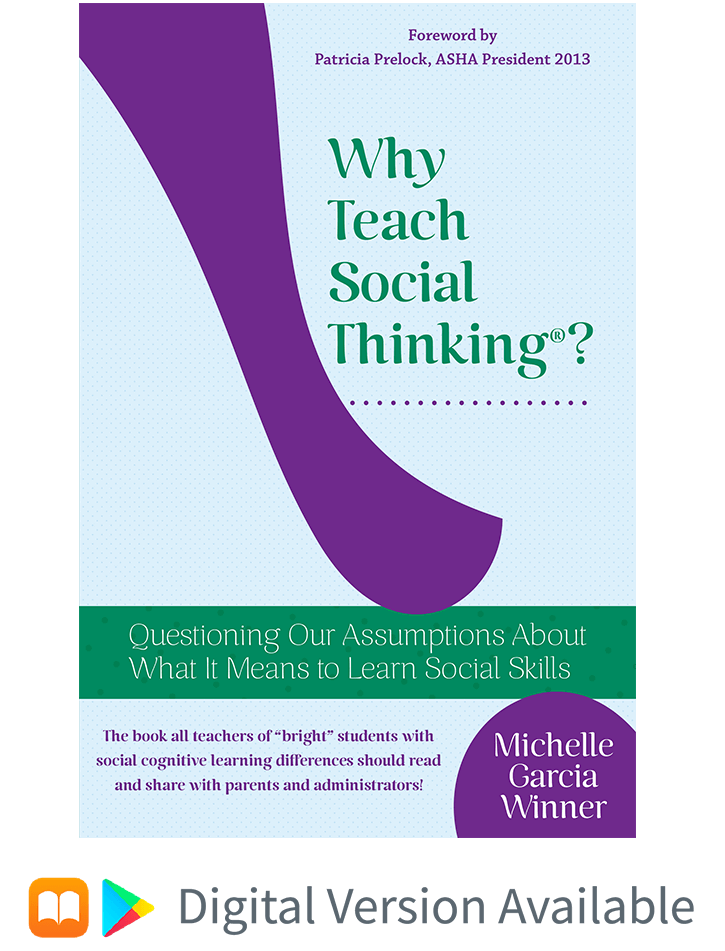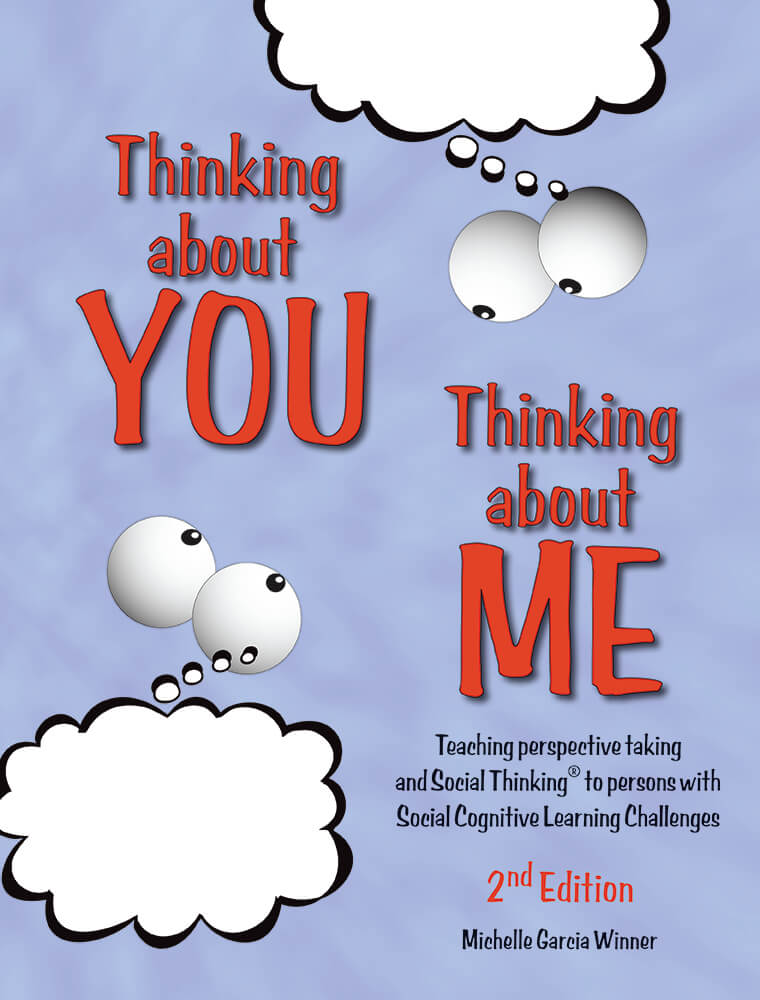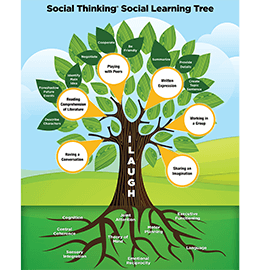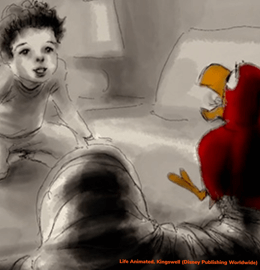Updated: August, 2022
© 2022 Think Social Publishing, Inc.
At just about every conference, people ask for ways to describe what we mean by Social Thinking in a few words or a short paragraph. “Sound bites—that’s what they need,” I think to myself. “Easy-to-remember phrases that capture the essence of what we’re trying to do with the curricula and materials we create for our public.” I hope you find a few bits of information to clarify what we mean by the term, Social Thinking.
Q. We think Social Thinking is pretty cool; we just can’t explain it very well to others. How did it get started and how would you summarize what you and your team have created over time?
Since 1995, I have been wrestling with the concept of how to teach social skills. So, I asked myself a fairly simple question: “Why do we use social skills and how do we learn them?”
I was certain about this then and am now: people with sophisticated social skills do not simply memorize and apply social skills across all situations. Social skills are produced based on our awareness of the situation, the presence (or absence) of people in it, what is happening in the situation, interpreting what we observe, and then deciding (or problem solving) what to say or do (or not say and do).
So, what is the point of using our social skills?
The goal in using social skills is to be able to affect how people react and respond to us in the manner we want. Sometimes we want to keep people feeling neutral or okay around us and other times we want them to go away, for safety or because we need time and space. Our social skills help us accomplish our social goals.
I began teaching what I called “Social Thinking” to help students learn that the larger social learning process is more than just memorizing and using a set of social behaviors. Instead, we started to focus on the underlying thinking related to the “why” of producing social skills. That process starts in our minds and then transfers to what we do and say when sharing space with others.
Q. In the Social Thinking Methodology, you focus on teaching students what they need to learn to get along with others?
Well, it’s not quite that simple. There’s more.
I discovered that most people don’t remember much about how they acquired their social skills since they seemed to learn them through osmosis. Most children learn intuitively to focus on people, their bodies, and their social interactions. The process starts first with their parents and then expands outward. Through this fusion of thinking, emotions, physical awareness, and experiences interacting with people across a range of situations, we typically learn strategies for developing and maintaining relationships. That’s the process for most folks.
Now think about Neurodivergent children who may not intuitively focus on the social world. This is the case for some neurotypically developing students too. They may need explicit teaching about how the social world works to gain social knowledge. But this is where most teachers and parents struggle because they personally didn’t need specific or concrete instruction. Sure, they had to learn about math, reading, science, but not social. If we, as parents and professionals, want to teach our children/students more information about the process through which we ultimately learn social skills, we first need to understand it ourselves. That’s where I found I needed to create a way to teach adults how to understand how the social world works in order to be better teachers for our students. I wanted them to get away from just demanding “good social skills” and get to the heart of what it means to be a social learner who has their own social goals.
It turns out that thinking socially helps us all interpret and respond to people (their thoughts, emotions, and behaviors) and what we learn about them as they interact within and between situations. These early social learning traits help us become good social observers in a natural way. We use social observation voyeuristically in watching and learning about others as much as we use it to guide what we do and say within our personal interactions.
Social observations also help us interpret what others may be doing or thinking when we’re not part of the immediate social situation. Some examples include interpreting characters, settings, motives, etc. when reading literature, studying history, watching virtually any TV show or movie, or when writing an email, story, essay, or book. We use social thinking whether we’re in the presence of others or not!
Our social mind is our “meaning maker.” Without our social mind, learning tends to be rote, fact-based, and devoid of interpretation.
Q: So, the social mind isn’t just about chatting or hanging out, it’s about schoolwork too?
Exactly! The social mind is critical for making sense of so much of the information taught through academic standards. For example, any standard that encourages a student to consider another’s point of view, compare and contrast plotlines, explain information in a logical sequence, use vocabulary to refine and enhance meaning, infer or predict actions, or summarize plots or themes is rooted in the processing that occurs in the social mind. These are all terms that are used in academic standards around the world!
By helping students sharpen how they think socially, we provide better cognitive tools for them to understand and succeed with their curricula, as well as develop healthier interpersonal relationships, including improved conflict resolution skills.
How we think socially develops and evolves over time. For instance, the way we apologize, ask for help, or kindle a friendship as a child in kindergarten is very different from what we do as adults. The core social thinking we learn as children lays the foundation for us to become more mature as our social competencies keep expanding across our lives. The socially based critical thinking that helps us write a persuasive essay in eighth grade may be exactly the same type of thinking we’ll use in our adult lives in our partnerships/marriages, during job interviews, in business meetings, when seeking out new customers, or while marketing a product.
Basically, from the time we develop solid language and thinking skills in preschool and beyond, we use our social mind to help us navigate and respond to the information around us. This requires us to consider our own and others’ perspectives.
We've created a brief but excellent audio-visual description of Social Thinking that you may also find useful in understanding and explaining the concept of Social Thinking: Socialthinking - What is Social Thinking?
Q: If you were going to try to explain this to a really busy administrator or someone in a human resources department, what would you say to motivate them to learn more?
I might say: “Most of us take for granted that our brains naturally think socially. All of us need a little help at times figuring out how to manage ourselves in the social world and we can all benefit from exploring our own and others’ social expectations. That said, Social Thinking is a company that has developed a methodology filled with practical strategies and curricula to teach more social and emotional learning and competencies to co-exist with one another while meeting our own social goals. These same core concepts also help us develop stronger insights and socially based critical thinking for solving social problems, interpreting literature, writing emails, understanding a video clip, etc. We can all better express our own ideas to others if we stop to consider that we notice one another and we can’t help but have thoughts and feelings about what we do and say.
For a boss or HR director, I might say…
“It’s our social mind that keeps people working together, not only in the classroom but also in a company. It helps us figure out what people mean by what they say and do and we can respond to keep others feeling okay or neutral or less confused. The Social Thinking Methodology is for those social learners with fair to strong language and cognition and has strategies to help people throughout their lives.”
And there you have it—a short summary and some sound bites to help you talk about and explain the Social Thinking Methodology to others.
We've created a brief but excellent audio-visual description of Social Thinking that you may also find useful in understanding and explaining the concept of Social Thinking: Socialthinking - What is Social Thinking?
Who Benefits from the Social Thinking Methodology?
We are all social emotional learners. Over the course of our lives, we cycle through different phases of gathering knowledge about how the social world works and then use that information to work (navigate to regulate) in the social world. Being a social emotional learner is a lifelong process.
The Social Thinking Methodology has age-based and strength-based products and materials for social emotional learners, ages four throughout adulthood. We define social emotional learners as both neurotypical and Neurodivergent (e.g., ADHD, social communication, social anxiety, twice-exceptional, sensory processing, specific learning disabilities, autism levels 1 and 2). Social emotional learners who benefit from our methodology are those who “learn with language” and “think and talk about thinking.”














